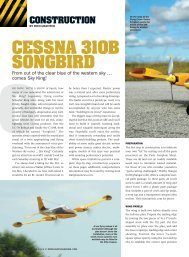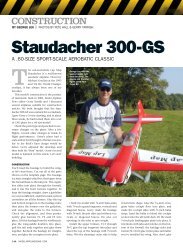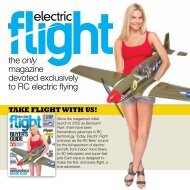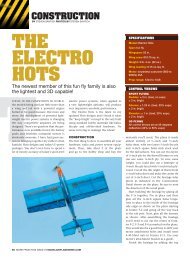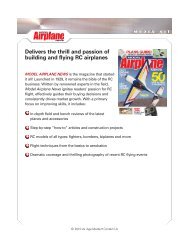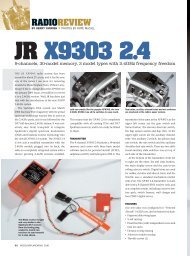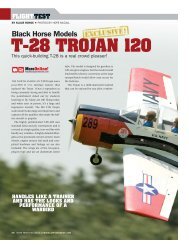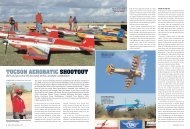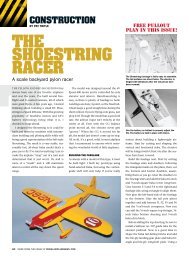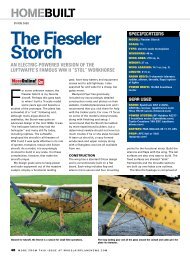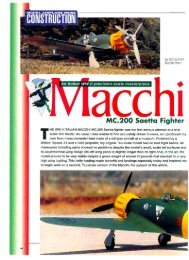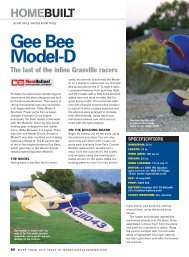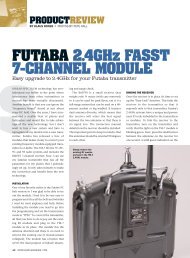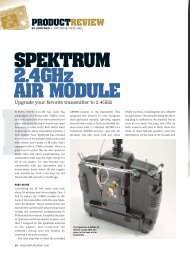Create successful ePaper yourself
Turn your PDF publications into a flip-book with our unique Google optimized e-Paper software.
DESIGN AND BUILD AN RC BIRD MODEL<br />
FLYING LIKE A BIRD<br />
It was a calm Saturday morning, and as I walked outside for the<br />
morning paper, I spotted a raven gliding toward me at telephone-pole<br />
height. Although this is a common sight here in the California desert,<br />
I stopped to watch. I had just retired from the Air Force Flight Test<br />
Center as a stability and control flight-test engineer, and now I had time<br />
to expand my interest in bird flight as a new hobby. As I watched, the<br />
raven started a slow bank to the right with its wings fully outstretched.<br />
The turn got steeper and steeper until, at last, the raven dived-head-<br />
first—into the middle of the road, about 30 yards in front of me. I was<br />
dumbfounded. I had never seen a bird crash before!<br />
Span • 4.17 ft. Length • 1.92 ft.<br />
Wing area = 2.78 sq. ft. Aspect ratio = 6.2S<br />
Weight = 1.1 Ib.<br />
BASE-LINE RAVEN<br />
There was no evidence of life after the impact, and I suspected that<br />
the bird had suffered a stroke or a heart attack. In any case, this little<br />
fellow had unwittingly given his life to science. I seized the opportunity<br />
to weigh him and draw an outline of his wings and tail on a sheet of<br />
butcher paper. The dimensions were surprisingly similar to a ^A-size<br />
radio-controlled model that I had been flying. I reasoned that I could<br />
probably learn something about how birds fly by building a glider model<br />
with the same shape, size and planform of a large soaring bird.<br />
I hoped to establish a "base-line" configuration that would fly, even<br />
if I had to cheat a little at the beginning. The starting point was a series<br />
of small, balsa-wood, profile models with 6- to 8-inch spans that I<br />
glided around the living room. I was a little surprised to find that these<br />
models were stable in all axes, even without vertical tails. Lateral<br />
control was an enigma, but I soon discovered that either spoilers or<br />
drag flaps caused the model to turn toward the high-drag wing.<br />
To provide room for the radio gear, I built the prototype Raven<br />
model about 8 percent larger than a real raven. Pitch control was<br />
provided by deflection of the rear portion of the tail, and lateral-<br />
directional control was provided by the use of drag flaps (downward<br />
only) on the bottom of each wing. I built it to be sturdy, since I expected<br />
frequent crashes. The model was launched from the top of a small hill.<br />
It appeared to be stable but glided with a gentle rolling oscillation that<br />
could not be controlled with the drag flaps, so a very small vertical fin<br />
was added. Stable and controllable glides were then possible.<br />
It seems that each successful test produces additional, unanswered<br />
questions, such as: how do birds twist their wingtip feathers to produce<br />
proverse yaw? Does a bird's airfoil really have a reflexed trailing edge<br />
in flight? Do birds adjust the wing sweep at the wingtips as part of the<br />
control mechanism? Of course, there is also a wide variety of species<br />
with various wing shapes to try. I have only begun to explore the<br />
technical aspects of how birds really fly. I am constantly amazed at<br />
the incredible complexity of bird flight, and I marvel at that little<br />
"bird-brain" that's able to coordinate all the required actions.<br />
For the full story, take the "Click Trip"!<br />
94 MODEL AIRPLANE NEWS<br />
The aileron servo for each wing<br />
panel is attached to the root<br />
end of the wing. This keeps the<br />
tips light for better turning per-<br />
formance. A Kimbrough rotary<br />
coupler connects the torque<br />
rod to the servo.<br />
Left: without a vertical fin<br />
and rudder, bird models<br />
can be very difficult to<br />
launch with a bungee<br />
high-start or a winch line.<br />
To improve the ride, you<br />
can use a drop-away<br />
ventral fin like this one<br />
that fits into a slot in the<br />
bottom of the fuselage.<br />
hints spur some interest in building models that look and fly like birds.<br />
The analysis methods mentioned are good starting points, but they do<br />
not ensure that a new bird model will fly well on the first launch. There<br />
is still much to learn about how birds fly.<br />
BUILDING A TURKEY VULTURE<br />
Early flights of my Turkey Vulture model oscillated continuously in roll.<br />
I made three changes to help it fly better. First, I built a new, lighter<br />
wing. Next, I replaced the drag flaps with wingtip-aileron feathers, and<br />
third, I installed Kimbrough rotary-drive couplers to control all moving<br />
surfaces. In its current configuration, the model oscillates lightly in<br />
turbulence, much as a real bird does, but it's easily controlled and will<br />
stabilize nicely in still air.<br />
The model is based on photos of vultures flying in thermals. It is<br />
approximately full size (66-inch span) but is roughly half the weight of a<br />
real turkey vulture. The wing construction incorporates a full-depth spar<br />
and a cambered-wing airfoil with reflex. The fuselage (body) is built with<br />
balsa formers, sheeting and balsa blocks for the head and minor fairing<br />
pieces. I cover my bird models with MonoKote film and paint the heads<br />
to match. This results in a model that is a true floater but does not penetrate<br />
the wind as well as a model<br />
with less camber. The model handles<br />
ballast well, and this can be used to<br />
somewhat improve penetration. Real<br />
soaring birds reduce their wingspan<br />
and area and increase their wing<br />
sweep when flying straight between<br />
thermals (more options for<br />
experimentation?).<br />
Detailed instructions for building<br />
the Turkey Vulture model<br />
accompany the full-size plan.<br />
You can also view the detailed article<br />
and some related aerodynamic illustrations<br />
via the "Click Trip" Web<br />
address at the end of this article.<br />
Please let me know, through Model<br />
Airplane News, of your experiences<br />
with bird-like flight. ±<br />
MODELAIRPLANENEWS.COM<br />
For more information and to<br />
see the model fly, click on<br />
the article and videos link.



